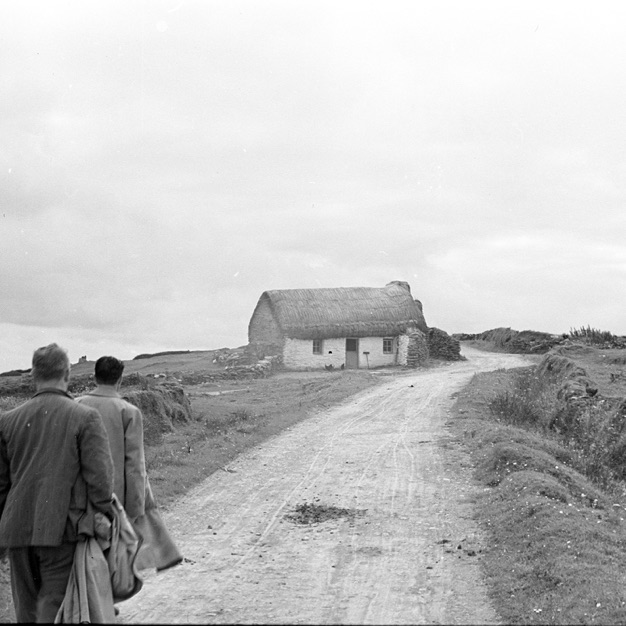Blúiríní Béaloidis 33 - Death (with David McGowan)
In life, there is much which seems uncertain to us. Concerning death however, there can be no doubt. It was an honour to speak with funeral director, death-care practitioner and proud Sligo native David McGowan on the topic of death for episode 33 of Blúiríní Béaloidis. Sit with us as we explore attitudes and customs regarding death and dying, from the practicalities and preparations of the corpse, to the wake house and beliefs regarding the departure of the soul. The episode features a good deal of archival audio from NFC collections, details of which can be found below. I'd like to thank David for being so generous with his time and knowledge, and send special thanks likewise to Síle Denver and the group Líadan, for permission to include their beautiful rendition of Amhrán Mhuínse to close the episode - baochas ó chroí libh uiléir. "Lord have mercy on the souls of the dead!"
Stream 'The Funeral Director' for free here: https://www.rte.ie/player/movie/the-funeral-director/118399528355
Support Líadan here: https://liadan.ie/
Archival audio timecodes:
12:24 - 13:50: Tom Dolan, Kinnegad, county Westmeath describes the 'crippling' that occurs to a body after death. Refers to a joke played at the wake house when hunched corpse was sat upright and had a pipe placed in its mouth. Rec. by Leo Corduff (1970) NFC T0504
13:51 - 14:39: James Grady, Lecarrow, county Roscommon describes how the corpse was laid out on a board to keep it straight, as it stiffens after death. Rec. by Jim Delaney (1961) NFC T0152
18:21 - 19:59: Michael Keenan, Lenamore, county Longford playing 'The Bucks of Oranmore' on the pipes. Rec. by Jim Delaney (1957) NFC T0023
22:42 - 26:33: Mrs. Meath, Ballyhaunis county Mayo describes beliefs regarding wakes, along with neighbourly assistance at the time of a death in the locality. Rec. by Leo Corduff and Ciarán Bairéad (1965) NFC T0298
26:34 - 27:21: Unidentified female singer on Aran islands, county Galway, giving example of keen for the dead (traditional lament). Rec. by Sidney Robertson Cowell(1957) NFC C0714
27:22 - 27:58: Eibhlín ní Mhurchú, Dundrum, county Dublin (formerly Baile Loiscithe, Kilmalkeader, county Kerry) describes keening lament as heard at wakes in her youth. Rec. by Ríonach Uí Ógáin (1995) NFC T2213
27:59 - 28:40: Brídín Iarnáin, Inis Mór, county Galway, giving example of traditional keen for the dead (1949) NFC C0161
37:30 - 39:01: James Grady, Lecarrow, county Roscommon describes how men would be sent for wake provisions. Gives humorous account of the carpenter who, fond of drink, keeps returning to house to measure the body for coffining, receives a fresh drink each time he enters. Rec. by Jim Delaney and Leo Corduff (1961) NFC T0152
39:02 - 39:54: Anne Kiernan, Kinnegad, Cloncrave, county Westmeath, describes the provisions laid on at the wake. Rec. by Leo Corduff (1971)NFC T0545
43:11 - 44:41: Stephen Dunne, Bride Street, the Liberties, Dublin describes the washing of the corpse by a charitable neighbour woman. Rec. by Jim Delaney (1968) NFC T0425
44:42 - 46:46: James Grady, Lecarrow, county Roscommon describes the washing and laying out of the corpse by local women. Rec. by Jim Delaney and Leo Corduff (1961) NFC T0152
58:52 - 1:01:07: Anne Kiernan, Kinnegad, Cloncrave, county Westmeath, describes return of a soul to pay a debt. Rec. by Leo Corduff (1971) NFC T0545
1:01:07 - 1:03:14: Jack Foley, county Down describes the earthly wandering of purgatorial souls (1958) NFC T0063
1:03:15 - 1:04:20: Mary Walsh, Kinnegad, county Westmeath, describes apparitions prior to a death, and visions of the recently deceased. Rec. by Leo Corduff(1970) NFC T0505
1:04:20 - 1:06:02: Michael Dolan, Glangevlin, county Cavan describes how a man used speak with the ghosts of his two sons, killed in the Great War of 1914-18. Rec. by Michael J. Murphy (1972) NFC T0587
19 November 2021, 8:09 pm
